The 3-wheel sit-down counterbalance forklift segment is expected to grow from USD 1.3 billion in 2025 to USD 2.0 billion by 2035, reflecting a 4.3% CAGR, driven by warehouse space optimization and the adoption of compact material-handling equipment in high-density storage environments. These forklifts are selected for tight turning radius performance, allowing operators to reduce aisle width while maintaining standard load capacity and operator visibility, which is critical in manufacturing, warehousing and e-commerce logistics centers. The period from 2025 to 2030 is expected to mark the technology consolidation phase, during which hybrid power platforms gain wider adoption due to their balance of runtime efficiency and lower charging downtime. From 2030 onward, market development is expected to shift toward lithium battery–fuel dual-mode configurations and deeper integration with warehouse management systems (WMSs), enabling fleet telemetry, energy usage tracking, and coordinated material flow routing.
Asia Pacific is anticipated to lead growth, supported by logistics infrastructure expansion and automation upgrades in China and India. Europe and North America are expected to maintain steady replacement-driven demand linked to facility modernization and safety compliance programs. Key competitive differentiation factors include battery system durability, onboard safety controls, telematics compatibility, and service network reliability. Market constraints include acquisition costs, stability limitations for heavy-duty loads, and varying compatibility across facility layouts. Despite this, the segment’s operational value in aisle utilization improvement and fleet productivity positions it as a core asset in modern warehouse and production environments.
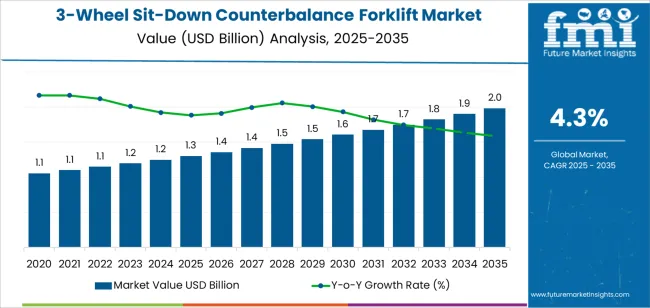
3-Wheel Sit-Down Counterbalance Forklift Market Year-over-Year Forecast (2025-2035)
The latter half (2030-2035) will witness sustained growth from USD 1,646.0 million to USD 2 billion, representing an addition of USD 385.7 million or 55% of the decade's expansion. This period will be defined by mass market penetration of lithium battery-fuel dual mode designs, integration with warehouse management platforms, and seamless compatibility with existing material handling infrastructure. The market trajectory signals fundamental shifts in how warehouse operators approach space optimization and operational efficiency management, with participants positioned to benefit from sustained demand across multiple power types and application segments.
The 2025-2030 phase adds USD 312.4 million to market value, representing 45% of total decade expansion. Market maturation factors include standardization of warehouse equipment protocols, declining component costs for specialized power systems, and increasing industry awareness of space optimization benefits reaching tight-aisle operations and confined warehouse applications. Competitive landscape evolution during this period features established material handling manufacturers like Crown Equipment and Toyota Material Handling expanding their 3-wheel forklift portfolios while automation specialists focus on advanced navigation development and enhanced maneuverability capabilities.
From 2030 to 2035, market dynamics shift toward intelligent power management and global logistics expansion, with growth continuing from USD 1,646.0 million to USD 2 billion, adding USD 385.7 million or 55% of total expansion. This phase transition centers on dual-mode power systems, integration with warehouse automation networks, and deployment across diverse manufacturing and distribution scenarios, becoming standard rather than specialized applications. The competitive environment matures with focus shifting from basic lifting capability to comprehensive fleet optimization systems and integration with inventory management platforms.
At-a-Glance Metrics
| Metric | Value |
|---|---|
| Market Value (2025) | USD 1.3 billion |
| Market Forecast (2035) | USD 2 billion |
| Growth Rate | 4.3% CAGR |
| Leading Technology | Hybrid Type Power System |
| Primary Application | Manufacturing Warehousing |
The market demonstrates strong fundamentals with hybrid power type systems capturing a dominant share through advanced energy management and operational flexibility capabilities. Manufacturing warehousing applications drive primary demand, supported by increasing facility automation and space optimization requirements. Geographic expansion remains concentrated in developed markets with established logistics infrastructure, while emerging economies show accelerating adoption rates driven by e-commerce warehouse expansion and rising operational efficiency standards.
Market expansion rests on three fundamental shifts driving adoption across manufacturing, logistics, and port terminal sectors. First, space optimization demand creates compelling operational advantages through 3-wheel sit-down forklifts that provide immediate maneuverability improvement and aisle width reduction without compromising load capacity standards, enabling warehouse operators to meet storage density targets while maintaining equipment safety and reducing facility footprint requirements significantly. Second, warehouse modernization accelerates as logistics facilities worldwide seek advanced material handling systems that complement automated storage processes, enabling precise navigation control and turning radius minimization that align with lean warehouse standards and operational requirements.
Third, operational efficiency enhancement drives adoption from manufacturing facilities and distribution centers requiring effective material handling solutions that maximize productivity while maintaining operator comfort during extended shift operations and tight-space maneuvering. However, growth faces headwinds from equipment cost challenges that vary across forklift manufacturers regarding power system complexity and stability engineering requirements, which may limit adoption in cost-sensitive warehouse environments. Technical limitations also persist regarding load capacity constraints and stability considerations that may reduce effectiveness in heavy-duty applications, which affect operational versatility and application range.
The 3-wheel sit-down counterbalance forklift market represents a specialized yet critical material handling opportunity driven by expanding global warehouse operations, logistics facility modernization, and the need for superior space utilization in diverse industrial applications. As warehouse operators worldwide seek to achieve storage density improvement, reduce operational costs, and integrate advanced material handling systems with automation platforms, 3-wheel forklifts are evolving from basic lifting equipment to sophisticated maneuvering solutions ensuring operational excellence and facility competitiveness.
The market's growth trajectory from USD 1.3 billion in 2025 to USD 2 billion by 2035 at a 4.3% CAGR reflects fundamental shifts in warehouse operations requirements and material handling optimization. Geographic expansion opportunities are particularly pronounced in Asia Pacific markets, while the dominance of hybrid power systems and manufacturing warehousing applications provides clear strategic focus areas.
Strengthening the dominant hybrid power type segment through enhanced battery technology, superior energy recovery, and intelligent power management systems. This pathway focuses on optimizing energy consumption, improving operational runtime, extending equipment effectiveness to multi-shift operations, and developing specialized configurations for demanding applications. Market leadership consolidation through advanced power electronics engineering and fleet management integration enables premium positioning while defending competitive advantages against single-mode power systems. Expected revenue pool: USD 95-125 million
Rapid e-commerce growth and warehouse facility expansion across Asia Pacific creates substantial opportunities through local manufacturing capabilities and distribution network partnerships. Growing third-party logistics operations and government infrastructure initiatives drive sustained demand for advanced material handling systems. Localization strategies reduce procurement costs, enable faster service support, and position companies advantageously for warehouse programs while accessing growing domestic markets. Expected revenue pool: USD 80-110 million
Expansion within the dominant manufacturing warehousing segment through specialized forklift designs addressing production facility standards and high-throughput operation requirements. This pathway encompasses assembly line integration, quality control features, and compatibility with diverse manufacturing processes. Premium positioning reflects superior maneuverability performance and comprehensive safety compliance supporting modern production facility operations. Expected revenue pool: USD 75-105 million
Strategic expansion into logistics center applications requires enhanced automation compatibility and specialized configurations addressing distribution center operational requirements. This pathway addresses high-velocity operations, automated guided vehicle integration, and warehouse management system connectivity with advanced navigation engineering for demanding throughput standards. Premium pricing reflects specialized performance requirements and extended operational duty cycles. Expected revenue pool: USD 65-90 million
Development of specialized forklift configurations for port terminal applications and other segments, addressing specific outdoor operation requirements and heavy-duty handling demands. This pathway encompasses weather-resistant designs, extended visibility systems, and ruggedized components for challenging maritime environments. Technology differentiation through environmental adaptability enables diversified revenue streams while reducing dependency on indoor warehouse platforms. Expected revenue pool: USD 55-75 million
Expansion of lithium battery-fuel dual mode segment through enhanced operational flexibility, rapid energy replenishment, and extended runtime capabilities. This pathway encompasses 24/7 operation support, opportunity charging integration, and seamless power source switching requiring advanced energy management architecture. Market development through dual-mode engineering enables differentiated positioning while accessing continuous operation facilities requiring maximum uptime solutions. Expected revenue pool: USD 45-65 million
Development of intelligent forklift systems addressing autonomous operation and predictive maintenance requirements across manufacturing and logistics applications. This pathway encompasses sensor integration, artificial intelligence navigation, and comprehensive fleet monitoring functionality. Premium positioning reflects technology leadership and automation expertise while enabling access to smart warehouse programs and Industry 4.0 partnerships. Expected revenue pool: USD 35-50 million
Primary Classification: The market segments by power type into Hybrid Type, Lithium Battery-Fuel Dual Mode, and Others categories, representing the evolution from basic electric power systems to advanced multi-mode energy solutions for comprehensive material handling optimization.
Secondary Classification: Application segmentation divides the market into Manufacturing Warehousing, Logistics Center, Port Terminal, and Others sectors, reflecting distinct requirements for load capacity, operational duration, and maneuverability standards.
Regional Classification: Geographic distribution covers Asia Pacific, Europe, North America, and other regions, with developed markets leading adoption while emerging economies show accelerating growth patterns driven by logistics infrastructure expansion programs.
The segmentation structure reveals technology progression from conventional electric systems toward hybrid power solutions with enhanced efficiency and operational flexibility capabilities, while application diversity spans from manufacturing floor operations to specialized port handling requiring precise material handling equipment.
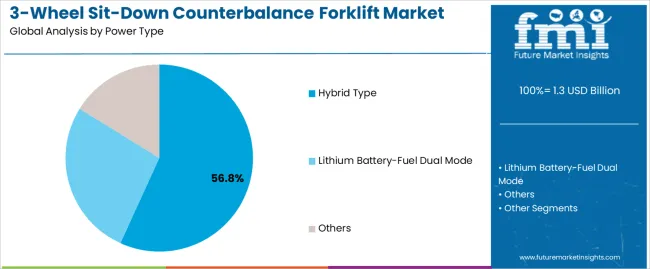
Market Position: Hybrid power type systems command the leading position in the 3-Wheel Sit-Down Counterbalance Forklift market with approximately 56.8% market share through advanced energy features, including regenerative braking capability, intelligent power switching, and battery life optimization that enable warehouse operators to achieve optimal operational efficiency across diverse manufacturing and logistics environments.
Value Drivers: The segment benefits from operator preference for versatile power systems that provide extended runtime, reduced energy costs, and operational flexibility without requiring dedicated charging infrastructure modifications. Advanced hybrid features enable seamless power mode transitions, energy consumption monitoring, and compatibility with existing warehouse electrical systems, where operational continuity and energy efficiency represent critical performance requirements.
Competitive Advantages: Hybrid power type systems differentiate through proven energy savings, consistent operational performance, and integration with fleet management systems that enhance operational effectiveness while maintaining optimal load handling suitable for diverse warehouse applications.
Key market characteristics:
Lithium battery-fuel dual mode systems maintain strategic positioning in the 3-Wheel Sit-Down Counterbalance Forklift market due to their maximum flexibility advantages and continuous operation capabilities. These systems appeal to warehouse operators requiring 24/7 operation capability, rapid energy replenishment, and elimination of battery change procedures for intensive distribution operations. Market adoption is driven by high-throughput facility emphasis, featuring opportunity charging capability and operational continuity through optimized dual-mode power systems while maintaining maximum equipment availability.
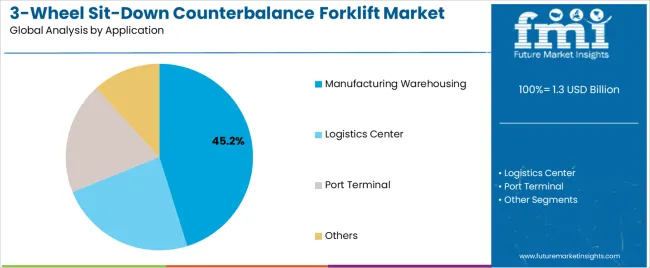
Market Context: Manufacturing warehousing applications dominate the 3-Wheel Sit-Down Counterbalance Forklift market with approximately 45.2% market share due to widespread adoption of space-efficient material handling and increasing focus on production floor optimization, lean manufacturing, and just-in-time inventory applications that minimize aisle requirements while maintaining automotive and industrial manufacturing standards.
Appeal Factors: Manufacturing facility operators prioritize equipment maneuverability, operator visibility, and integration with existing production workflows that enables coordinated material handling across multiple production zones. The segment benefits from substantial manufacturing automation investment and facility optimization programs that emphasize the acquisition of compact forklifts for floor space maximization and material flow improvement applications.
Growth Drivers: Smart manufacturing modernization programs incorporate 3-wheel sit-down forklifts as standard equipment for production material handling operations, while automotive assembly expansion increases demand for maneuverable lifting capabilities that comply with lean manufacturing standards and minimize production disruption.
Market Challenges: Varying production facility layouts and material handling protocol differences may limit forklift standardization across different manufacturing sites or operational scenarios.
Application dynamics include:
Logistics center applications capture approximately 28.6% market share through specialized handling requirements in distribution center operations, third-party logistics facilities, and e-commerce fulfillment applications. These facilities demand efficient forklift systems capable of managing high-velocity operations while providing excellent visibility and space optimization capabilities.
Port terminal applications account for approximately 17.3%, while other segments capture 8.9%, including retail warehouse operations, cold storage facilities, and specialized industrial applications requiring 3-wheel forklift capabilities for space-constrained material handling and operational efficiency.
Growth Accelerators: Warehouse density optimization drives primary adoption as 3-wheel sit-down forklifts provide superior space utilization capabilities that enable facility operators to meet storage capacity targets without excessive aisle width requirements, supporting warehouse expansion missions that require efficient material handling applications. E-commerce logistics advancement demand accelerates market expansion as distribution centers seek effective maneuvering systems that maximize picking efficiency while maintaining operational safety during high-velocity order fulfillment and inventory rotation scenarios. Material handling equipment spending increases worldwide, creating sustained demand for compact forklift systems that complement warehouse automation infrastructure and provide productivity improvement in competitive logistics markets.
Growth Inhibitors: Equipment acquisition cost challenges vary across forklift manufacturers regarding stability engineering and power system sophistication requirements, which may limit operational flexibility and market penetration in regions with budget constraints or cost-sensitive warehouse operations. Technical performance limitations persist regarding load capacity constraints and stability considerations that may reduce effectiveness in heavy-duty applications, uneven surface conditions, or maximum weight scenarios, affecting operational versatility and application breadth. Market fragmentation across multiple warehouse automation standards and facility layouts creates compatibility concerns between different forklift manufacturers and existing material handling infrastructure.
Market evolution patterns show adoption accelerating in e-commerce distribution and manufacturing facility sectors where space efficiency justifies equipment investment costs, with geographic concentration in developed markets transitioning toward mainstream adoption in emerging economies driven by logistics infrastructure development and warehouse modernization awareness. Technology development focuses on autonomous navigation integration, lithium-ion battery advancement, and compatibility with warehouse management systems that optimize material flow and operational effectiveness. The market could face disruption if alternative material handling technologies or automated storage systems significantly limit the deployment of manned forklifts in warehouse applications, though 3-wheel sit-down forklifts' unique combination of maneuverability, operator comfort, and load capacity continues to make them preferred in space-constrained facilities.
The 3-Wheel Sit-Down Counterbalance Forklift market demonstrates varied regional dynamics with Growth Leaders including China (5.8% CAGR) and India (5.4% CAGR) driving expansion through logistics infrastructure capacity additions and manufacturing warehouse programs. Steady Performers encompass Germany (4.9% CAGR), Brazil (4.5% CAGR), and United States (4.1% CAGR), benefiting from established distribution networks and advanced warehouse automation adoption. Mature Markets feature United Kingdom (3.7% CAGR) and Japan (3.2% CAGR), where specialized manufacturing applications and logistics facility integration support consistent growth patterns.

| Country | CAGR (2025-2035) |
|---|---|
| China | 5.8% |
| India | 5.4% |
| Germany | 4.9% |
| Brazil | 4.5% |
| United States | 4.1% |
| United Kingdom | 3.7% |
| Japan | 3.2% |
Regional synthesis reveals Asia Pacific markets leading adoption through e-commerce warehouse expansion and logistics facility infrastructure development, while European countries maintain steady expansion supported by manufacturing automation advancement and warehouse efficiency standardization requirements. North American markets show moderate growth driven by distribution center applications and material handling equipment modernization integration trends.

The Chinese market emphasizes advanced forklift features, including intelligent navigation systems and comprehensive warehouse management integration that coordinate material handling, inventory tracking, and operational monitoring applications through unified logistics platforms. The country demonstrates strong growth at 5.8% CAGR, driven by e-commerce warehouse expansion, manufacturing facility modernization, and emerging automation industry development that support 3-wheel forklift integration. Chinese warehouse operators prioritize operational effectiveness with forklifts delivering consistent performance through advanced maneuverability capabilities and energy management features.
Technology deployment channels include major e-commerce companies, automotive manufacturers, and third-party logistics providers that support professional applications for complex warehouse operations and high-throughput distribution applications. Forklift integration capabilities with domestic warehouse management systems expand market appeal across diverse operational requirements seeking space optimization and productivity improvement benefits. The expanding logistics sector and accelerating warehouse automation create sustained demand, while innovative applications in smart warehousing and autonomous material handling open new growth avenues.
Performance Metrics:
Germany's advanced logistics market demonstrates sophisticated forklift deployment with documented operational effectiveness in automotive manufacturing applications and distribution center facilities through integration with existing warehouse automation systems and material flow infrastructure. The country leverages engineering expertise in material handling technology and industrial equipment integration to maintain strong growth at 4.9% CAGR. Industrial centers, including Stuttgart, Munich, and Hamburg, showcase advanced installations where forklift systems integrate with comprehensive warehouse platforms and production management networks to optimize material handling operations and facility effectiveness.
German warehouse operators prioritize system reliability and automation compatibility in forklift development, creating demand for certified systems with advanced features, including safety sensor integration and fleet management connectivity. The market benefits from established automotive manufacturing infrastructure and willingness to invest in material handling technologies that provide long-term operational efficiency benefits and compliance with international safety and quality standards.
Market Intelligence Brief:
The USA 3-wheel sit-down counterbalance forklift market demonstrates sophisticated deployment across distribution center applications with documented effectiveness in e-commerce fulfillment and retail warehouse facilities through integration with comprehensive warehouse management systems and logistics automation infrastructure. The country leverages advanced logistics capabilities in material handling innovation and supply chain optimization to maintain moderate growth at 4.1% CAGR. Distribution centers, including locations near major metropolitan areas and transportation hubs, showcase advanced installations where forklift systems integrate with comprehensive warehouse platforms and inventory management networks to optimize order fulfillment and handling effectiveness.
American warehouse operators prioritize productivity enhancement and automation integration in forklift development, creating demand for advanced systems with cutting-edge features, including telematics connectivity and predictive maintenance capabilities. The market benefits from established e-commerce infrastructure and willingness to invest in material handling equipment that provides long-term operational competitiveness benefits and compliance with OSHA safety standards.
Market Intelligence Brief:
The UK 3-wheel sit-down counterbalance forklift market demonstrates steady equipment adoption with documented operational effectiveness in retail distribution applications and manufacturing warehouse facilities through integration with existing material handling systems and logistics infrastructure. The country leverages technology expertise in supply chain management and warehouse operations optimization to maintain steady growth at 3.7% CAGR. Distribution centers, including London, Manchester, and Birmingham areas, showcase warehouse installations where forklift systems integrate with comprehensive inventory platforms and warehouse management networks to optimize space utilization and handling effectiveness.
British warehouse operators prioritize system efficiency and operational safety in forklift development, creating demand for compliant systems with advanced features, including operator assistance technology and comprehensive safety monitoring. The market benefits from established retail distribution infrastructure and commitment to invest in material handling equipment that provides long-term operational benefits and compliance with UK health and safety standards. E-commerce distribution applications, retail warehouse systems, and manufacturing logistics drive diversified demand across multiple facility segments.
Strategic Market Indicators:
India's 3-wheel sit-down counterbalance forklift market demonstrates rapid expansion with documented operational effectiveness in manufacturing warehouse applications and logistics facility operations through integration with emerging material handling systems and supply chain infrastructure. The country leverages growing industrial capabilities in warehouse equipment adoption and logistics facility development to achieve high growth at 5.4% CAGR. Industrial centers, including Mumbai, Delhi, and Bangalore, showcase expanding installations where forklift systems integrate with comprehensive warehouse platforms and distribution networks to optimize material handling efficiency and operational effectiveness.
Indian warehouse operators prioritize cost optimization and operational reliability in forklift development, creating demand for economical systems with essential features, including basic automation support and standard safety equipment. The market benefits from expanding manufacturing infrastructure and willingness to invest in material handling equipment that provides operational efficiency improvement and compliance with industrial safety standards.
Market Intelligence Brief:
Brazil's 3-wheel sit-down counterbalance forklift market demonstrates steady expansion with documented operational effectiveness in automotive manufacturing applications and distribution center facilities through integration with material handling systems and logistics infrastructure. The country leverages developing industrial capabilities in warehouse equipment adoption and facility modernization to maintain moderate growth at 4.5% CAGR. Industrial centers, including São Paulo, Curitiba, and Rio de Janeiro, showcase growing installations where forklift systems integrate with comprehensive warehouse platforms and production networks to optimize material handling operations and facility efficiency.
Brazilian warehouse operators prioritize operational durability and maintenance simplicity in forklift development, creating demand for robust systems with essential features, including reliable power systems and straightforward operation. The market benefits from expanding automotive sector and commitment to invest in material handling equipment that provides productivity improvements and operational capability benefits.
Strategic Market Indicators:
Japan's 3-wheel sit-down counterbalance forklift market demonstrates precision deployment with documented operational effectiveness in automotive manufacturing applications and advanced warehouse facilities through integration with sophisticated production control systems and material handling automation infrastructure. The country leverages engineering excellence in manufacturing equipment integration and precision operations to maintain steady growth at 3.2% CAGR. Industrial centers, including Toyota City, Yokohama, and Osaka, showcase advanced installations where forklift systems integrate with comprehensive quality management platforms and production automation networks to optimize manufacturing excellence and handling effectiveness.
Japanese warehouse operators prioritize system precision and long-term reliability in forklift development, creating demand for high-performance systems with advanced features, including micro-positioning capabilities and comprehensive safety systems. The market benefits from established automotive manufacturing infrastructure and commitment to invest in highest-quality material handling equipment that provides superior operational performance and compliance with stringent Japanese safety standards.
Strategic Market Indicators:
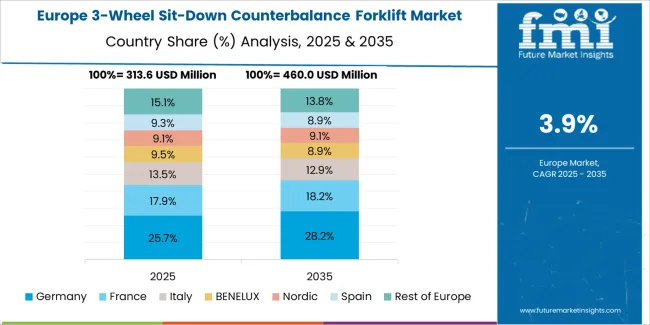
The 3-Wheel Sit-Down Counterbalance Forklift market in Europe is projected to grow substantially over the forecast period, with Germany expected to maintain its leadership position with a significant market share supported by its advanced automotive manufacturing infrastructure and major logistics centers in Stuttgart and Hamburg. France follows with strong market presence, driven by comprehensive retail distribution programs and manufacturing warehouse initiatives. The United Kingdom holds substantial market share through specialized e-commerce distribution activities, cold storage applications, and logistics facility operations. Italy commands notable market presence through strong automotive manufacturing and fashion logistics projects. Spain accounts for growing market share aided by logistics center expansion and manufacturing equipment adoption. The Netherlands maintains steady share driven by port logistics applications and distribution center demand. The Rest of Europe region is anticipated to show steady adoption, reflecting consistent growth in Nordic countries, logistics expansion in Central European markets, and warehouse modernization upgrades across Eastern European manufacturing facilities.
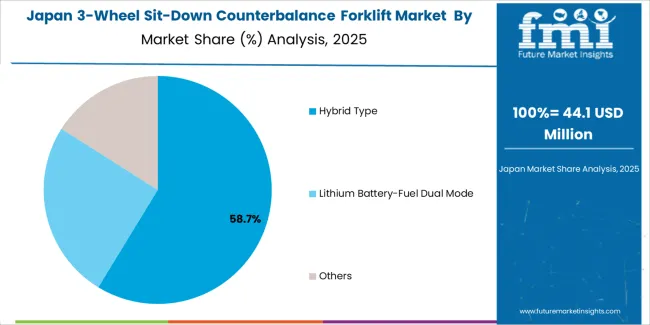
In Japan, the 3-Wheel Sit-Down Counterbalance Forklift market prioritizes hybrid power type systems, which capture the dominant share of automotive manufacturing and warehouse facility installations due to their advanced features, including precision energy management optimization and seamless integration with existing facility power infrastructure. Japanese warehouse operators emphasize reliability, energy efficiency, and long-term operational excellence, creating demand for hybrid systems that provide consistent material handling capabilities and superior operational performance based on facility requirements and quality standards. Lithium battery-fuel dual mode maintains secondary positions primarily in 24/7 distribution operations and high-intensity logistics installations where continuous operation meets requirements without compromising equipment availability.
Market Characteristics:

In South Korea, the market structure favors international material handling manufacturers, including Crown Equipment, Toyota Material Handling, and Jungheinrich, which maintain dominant positions through comprehensive product portfolios and established logistics networks supporting both large distribution center implementations and automotive manufacturing installations. These providers offer integrated solutions combining advanced forklift systems with professional technical support and ongoing service management that appeal to Korean warehouse operators seeking reliable material handling solutions. Local equipment distributors and service providers capture moderate market share by providing localized support capabilities and competitive pricing for standard warehouse forklift installations, while domestic manufacturers focus on specialized applications and cost-effective solutions tailored to Korean logistics market characteristics.
Channel Insights:
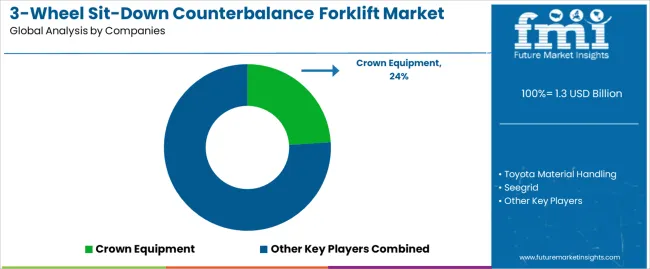
The 3-Wheel Sit-Down Counterbalance Forklift market operates with moderate concentration, featuring approximately 15-18 meaningful participants, where leading companies control roughly 55-60% of the global market share through established warehouse relationships and comprehensive material handling equipment portfolios. Competition emphasizes advanced maneuverability capabilities, power system efficiency, and fleet management integration rather than price-based rivalry. The leading company, Crown Equipment, commands approximately 24.0% market share through its extensive forklift product line and global material handling presence.
Market Leaders encompass Crown Equipment, Toyota Material Handling, and Seegrid, which maintain competitive advantages through extensive warehouse equipment expertise, global distribution networks, and comprehensive technical support capabilities that create customer loyalty and support premium pricing. These companies leverage decades of material handling experience and ongoing technology investments to develop advanced forklift systems with intelligent control features and safety integration capabilities. Technology Innovators include Jungheinrich, Mitsubishi Logisnext, and Anhui Heli, which compete through specialized power system technology focus and innovative design solutions that appeal to warehouse operators seeking advanced material handling capabilities and energy optimization.
These companies differentiate through rapid product development cycles and specialized application focus. Regional Specialists feature forklift manufacturers focusing on specific geographic markets and specialized applications, including automated guided vehicle systems and warehouse automation solutions. Market dynamics favor participants that combine reliable material handling performance with advanced system capabilities, including telematics integration and predictive maintenance features. Competitive pressure intensifies as traditional forklift suppliers expand into autonomous navigation systems, while specialized robotics companies challenge established players through innovative automated solutions and intelligent warehouse platforms targeting e-commerce distribution and manufacturing logistics segments.
| Item | Value |
|---|---|
| Quantitative Units | USD 1.3 billion |
| Power Type | Hybrid Type, Lithium Battery-Fuel Dual Mode, Others |
| Application | Manufacturing Warehousing, Logistics Center, Port Terminal, Others |
| Regions Covered | Asia Pacific, Europe, North America, Latin America, Middle East & Africa |
| Countries Covered | China, India, Germany, United States, United Kingdom, Japan, Brazil, and 20+ additional countries |
| Key Companies Profiled | Crown Equipment, Toyota Material Handling, Seegrid, Jungheinrich, Mitsubishi Logisnext, Anhui Heli, Hyster-Yale, KION Group, DS Automotion, BALYO, EK Robotics |
| Additional Attributes | Dollar sales by power type and application categories, regional adoption trends across Asia Pacific, Europe, and North America, competitive landscape with material handling manufacturers and warehouse automation suppliers, operator preferences for maneuverability and energy efficiency, integration with warehouse management platforms and fleet monitoring systems, innovations in autonomous navigation capabilities and lithium-ion technology, and development of hybrid power solutions with enhanced performance and operational optimization capabilities. |
The global 3-wheel sit-down counterbalance forklift market is estimated to be valued at USD 1.3 billion in 2025.
The market size for the 3-wheel sit-down counterbalance forklift market is projected to reach USD 2.0 billion by 2035.
The 3-wheel sit-down counterbalance forklift market is expected to grow at a 4.3% CAGR between 2025 and 2035.
The key product types in 3-wheel sit-down counterbalance forklift market are hybrid type, lithium battery-fuel dual mode and others.
In terms of application, manufacturing warehousing segment to command 45.2% share in the 3-wheel sit-down counterbalance forklift market in 2025.






Full Research Suite comprises of:
Market outlook & trends analysis
Interviews & case studies
Strategic recommendations
Vendor profiles & capabilities analysis
5-year forecasts
8 regions and 60+ country-level data splits
Market segment data splits
12 months of continuous data updates
DELIVERED AS:
PDF EXCEL ONLINE
4-Wheel Sit-Down Counterbalance Forklift Market Size and Share Forecast Outlook 2025 to 2035
Forklift Battery Market Size and Share Forecast Outlook 2025 to 2035
Forklift Attachments Market Growth - Trends & Forecast 2025 to 2035
Forklift-Mounted Computers Market
Autonomous Forklift Market Growth – Trends & Forecast 2024-2034
Cherry Picker Forklift Market Growth - Trends & Forecast 2025 to 2035

Thank you!
You will receive an email from our Business Development Manager. Please be sure to check your SPAM/JUNK folder too.
Chat With
MaRIA